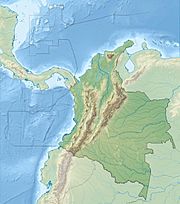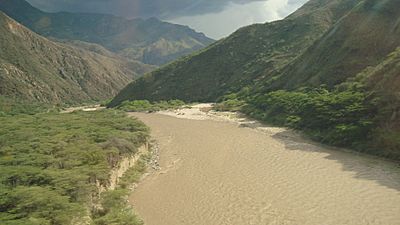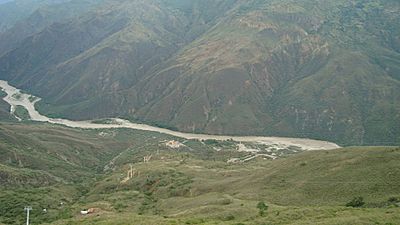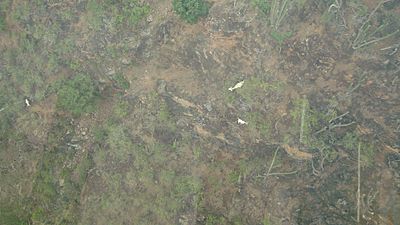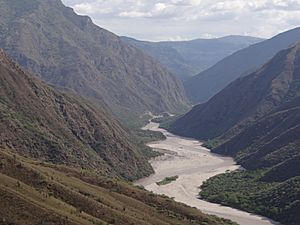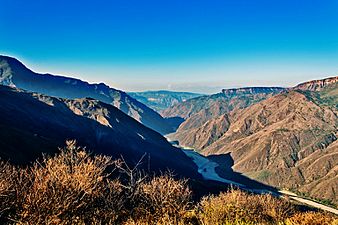Chicamocha Canyon facts for kids
Quick facts for kids Chicamocha Canyon |
|
|---|---|
| Cañón del Chicamocha | |
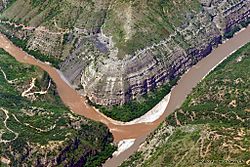
Chicamocha Canyon at the confluence of the Suárez and Chicamocha Rivers, and the Sogamoso River.
|
|
| Floor elevation | 900–1,900 m (3,000–6,200 ft) |
| Length | 227 km (141 mi) NW-SE |
| Area | 108,000 ha (270,000 acres) |
| Depth | 2,000 m (6,600 ft) |
| Geology | |
| Type | River canyon |
| Age | Oligocene-recent |
| Geography | |
| Country | |
| State | Boyacá & Santander |
| Region | Andean South American Plate Chibcha Terrane |
| District | Alto Chicamocha |
| Population centers | Soatá, Capitanejo, Cepitá, Pescadero, Jordán, Betulia, Girón |
| Borders on | Mesa de Los Santos (west, north, east) Altiplano Cundiboyacense (south) |
| Traversed by | National Route 45A |
| Rivers | Chicamocha River Suárez River Sogamoso River |
The Chicamocha Canyon (pronounced CHEE-kə-MOH-chə) is a huge, deep valley in Colombia. It was carved out by the Chicamocha River over millions of years. This amazing canyon is one of the biggest in the world! It stretches for about 227 kilometers (141 miles) and can be as deep as 2,000 meters (6,560 feet). That's deeper than some of the tallest buildings!
The canyon is located in the departments of Boyacá and Santander. It goes from the town of Soatá in the southeast all the way to Girón and Betulia in the northwest.
It's a very popular place for tourists, especially since it's only about 55 kilometers (34 miles) from Bucaramanga, a big city in Santander. A main highway, National Route 45A, crosses the canyon, offering incredible views of the river and the steep cliffs.
The Chicamocha Canyon started forming around 30 million years ago. At that time, the Earth's crust in Colombia was very active, pushing up the Andes mountains. This uplift, along with changes in the climate, helped create this massive canyon. Later, an ancient lake called Lake Soatá formed in the southern part of the canyon. Fossils of elephant-like animals called Notiomastodon have been found there!
Today, the canyon is managed by the Chicamocha National Park (also known as PANACHI). In 2009, the Chicamocha Canyon was considered for the "New 7 Wonders of Nature" list. It made it into the top 77 natural wonders! Since 2013, there's even a yearly running event called the Chicamocha Canyon Race held around the canyon.
Contents
What Does "Chicamocha" Mean?
The name Chicamocha comes from the Guane language, spoken by the ancient Muisca who lived here. It means "silver thread on a full moon night in the mountain range."
About the Canyon
The Chicamocha Canyon is one of the largest canyons in the world. It was formed by the powerful Chicamocha River slowly eroding the land. This created the very deep cliffs you see today.
The canyon starts near Soatá in the Boyacá region. It then flows mostly through Santander, ending near the town of Lebrija. The movement of Earth's tectonic plates helped create this amazing natural feature. South of Zapatoca, the Chicamocha River joins the Suárez River to form the Sogamoso River.
The climate in the canyon changes a lot. In the highest parts near Soatá, it's cold and humid. As you go deeper and further northwest, it gets much drier and hotter. The lowest areas are the hottest and driest. The plants you see in the northern part of the canyon are typical of a dry tropical forest.
Who Lived Here Before?
Before the Spanish arrived in Colombia, the Chicamocha Canyon region was home to the Guane. They were an indigenous group who lived in this area.
How Was the Canyon Formed?
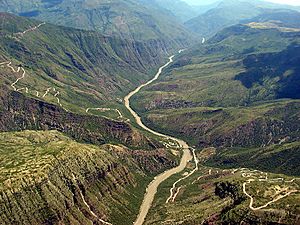
The rocks in the Chicamocha Canyon are very old, some dating back hundreds of millions of years! The youngest rocks are found in terraces around an ancient lake called Lake Soatá. This lake was probably about 400 meters (1,300 feet) deep and about 30 kilometers (19 miles) long.
Scientists have found fossils in these rocks, including parts of Haplomastodon waringi, which was a type of elephant-like animal. They also found fossils of giant capybaras (Neochoerus sp.) and deer (Odocoileus cf. salinae).
The canyon also has many different types of rocks, from very old ones like gneiss and schist to younger ones like sandstone and limestone. Several faults (cracks in the Earth's crust) also cross through the canyon, showing how much the land has moved over time. Near Barichara, a mineral called gypsum is mined from the canyon's sides.
Gallery
Panorama Views
See Also
 In Spanish: Cañón del Chicamocha para niños
In Spanish: Cañón del Chicamocha para niños
- Chicamocha National Park
- Geology of Colombia
- Tourism in Colombia
- List of canyons


